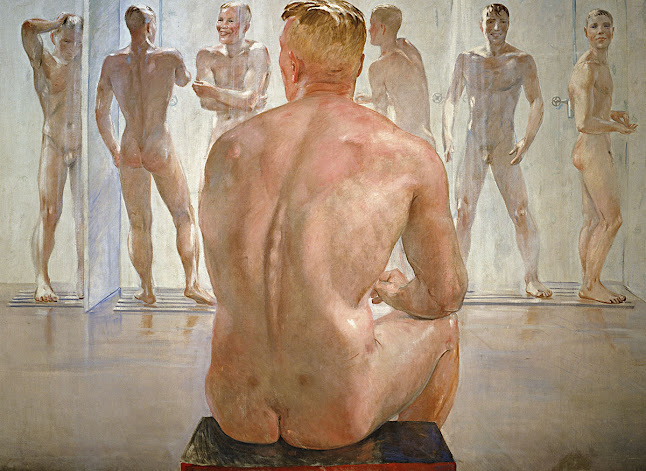Aleksandr Deyneka
Aleksandr Deyneka (or Deineka) (1899-1969) was a Russian artist during the Soviet period of Socialist Realism. This is a self-portrait from 1948.
Socialist realism was based on a Communist doctrine that art must serve the state. Western avant-garde art was considered decadent. Soviet art glorified the heroic worker and the heroic soldier. Deyneka produced a lot of art of this kind, such as Blacksmiths, 1957, above.
However, Deyneka was one of the few Soviet artists to portray male nudes. Stalin considered female nudes, in particular, to be pornography. Male nudes were also viewed with suspicion. But it was politically correct to promote a healthy lifestyle and to depict Soviet people with strong, healthy bodies, and Deyneka managed to thread this needle and avoid official criticism.
This is a 1935 photo by Boris Ignatovich of athletes getting a water massage from a Charcot shower, a jet of water held by the figure in the foreground. Ignatovich personally gave Deyneka a copy of the photo, which Deyneka admired and decided to recreate as a painting.
This is Deyneka's After the Battle, 1942. The naked men in the background are more prominent than in the photo, and they are taking conventional showers. By calling the painting After the Battle, Deyneka transformed the nudes into heroic soldiers, which fit the socialist realism ideology.
We see this as a good-looking guy taking a shower outdoors, but the title, After Work, tries to convince us that it's a painting of a productive Soviet worker, and the nude body is just incidental.
Perhaps in this case the title wasn't convincing enough, resulting in this version of After Work. Both versions are sometimes dated 1948 and sometimes 1956. I'm guessing that the nude version was done in 1948, but Deyneka painted a swimsuit over it in 1956 to avoid criticism.
This is A Fine Morning, 1959-1960, sometimes called Good Morning. Finally we have a Deyneka painting of naked young men just enjoying themselves without the pretense that they have to be heroic soldiers or workers serving the state.
Another copy of A Fine Morning exists as this mosaic. Deyneka provided mosaics to decorate two Moscow subway stations, including this one in the Mayakovskaya station. Mosaics are an extremely durable art form – there are mosaics from ancient Greece and Rome that are as bright and colorful today as they were thousands of years ago. Perhaps, thousands of years from now, archaeologists may uncover this mosaic, safely preserved in the subway.








4 comments:
There's a similar, smaller mural in the Broad St. station of the Newark (New Jersey) City Subway: https://sites.google.com/site/historictileinstallationsn/nj_newark--wpa-morris-canal-murals
Thanks, Jim. That's very interesting.
Artists today also need find ways to avoid haters
The Soviets must have had fits with his homoerotic artworks.
A very smart, wily artist working under great constraint.
Painting at a time of great tumult in Russia.
Stalin and his prison camps, soon to change with his death in 53.
The power vacuum left in its wake, the ascendancy of Khrushchev and post-Stalin reforms. The Geneva talks of 55 and the opening of the Soviet Union, the final settlement of Austria with guaranteed neutrality, Soviet troop withdrawal and peace treaty, and the final peace treaty for Japan. The 56 Party Congress and repudiation of Stalin and Stalinism. The gradual dismantling of the prisons and labor camps that had imprisoned millions, a great accomplishment on Khrushchev's part. For he had to confront the very men who built their careers on that system and were in no mood for any changes to that system. The prison population dropped from 3 million in 53 to 300,000 in 59 due to Khrushchev's demands. - Rj/IE
Post a Comment